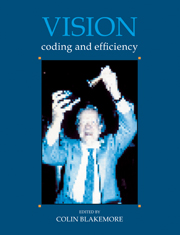Book contents
- Frontmatter
- Contents
- List of Contributors
- Preface
- Reply
- Acknowledgements
- Concepts of coding and efficiency
- Efficiency of the visual pathway
- 5 The design of compound eyes
- 6 The light response of photoreceptors
- 7 Is there more than meets the eye?
- 8 Quantum efficiency and performance of retinal ganglion cells
- 9 Neural interactions underlying direction-selectivity in the rabbit retina
- 10 Detection and discrimination mechanisms in the striate cortex of the Old-World monkey
- Colour
- Brightness, adaptation and contrast
- Development of vision
- Depth and texture
- Motion
- From image to object
- Index
10 - Detection and discrimination mechanisms in the striate cortex of the Old-World monkey
Published online by Cambridge University Press: 05 May 2010
- Frontmatter
- Contents
- List of Contributors
- Preface
- Reply
- Acknowledgements
- Concepts of coding and efficiency
- Efficiency of the visual pathway
- 5 The design of compound eyes
- 6 The light response of photoreceptors
- 7 Is there more than meets the eye?
- 8 Quantum efficiency and performance of retinal ganglion cells
- 9 Neural interactions underlying direction-selectivity in the rabbit retina
- 10 Detection and discrimination mechanisms in the striate cortex of the Old-World monkey
- Colour
- Brightness, adaptation and contrast
- Development of vision
- Depth and texture
- Motion
- From image to object
- Index
Summary
Introduction
The sensory systems of man measured at absolute threshold are extraordinarily sensitive. Under favourable conditions, the behavioural performance is close to perfect and the most significant limitations on the human observer are the physical limitations imposed by the nature of the detection task, such as the random fluctuations in the number of quanta arriving at the cornea from a flash of light of very weak intensity (Hecht et al, 1942), or limitations imposed at the transduction stages, such as random, thermallyinduced decomposition of photopigment molecules (Barlow, 1956). These demonstrations force one to consider a mechanistic question: namely, how is psychophysical performance of this quality supported by the individual elements of the nervous system, and, in particular, if the essential limitations on performance, even under a restricted set of conditions, can be shown to be either external to the organism or within the primary sense organs, how can information transmission be so reliable throughout the remainder of the system? In this work, we have examined the performance of neurons in the first visual cortical area of Old-World Primates (VI or striate cortex) on a number of tasks that have identifiable counterparts in perceptual behaviour.
There are a number of psychophysical tasks that are theoretically important in studying perceptual behaviour because they offer a ‘systems analysis’ of the visual system and its individual components. The study of these tasks has led to the steady evolution of a number of relatively sophisticated, quantitative models of early visual processing, which all incorporate the concept of a set of ‘receptive fields’ of different sizes or scales that are bandpass in the spatial frequency domain and orientation selective (Campbell & Robson, 1968).
- Type
- Chapter
- Information
- VisionCoding and Efficiency, pp. 103 - 116Publisher: Cambridge University PressPrint publication year: 1991
- 8
- Cited by



